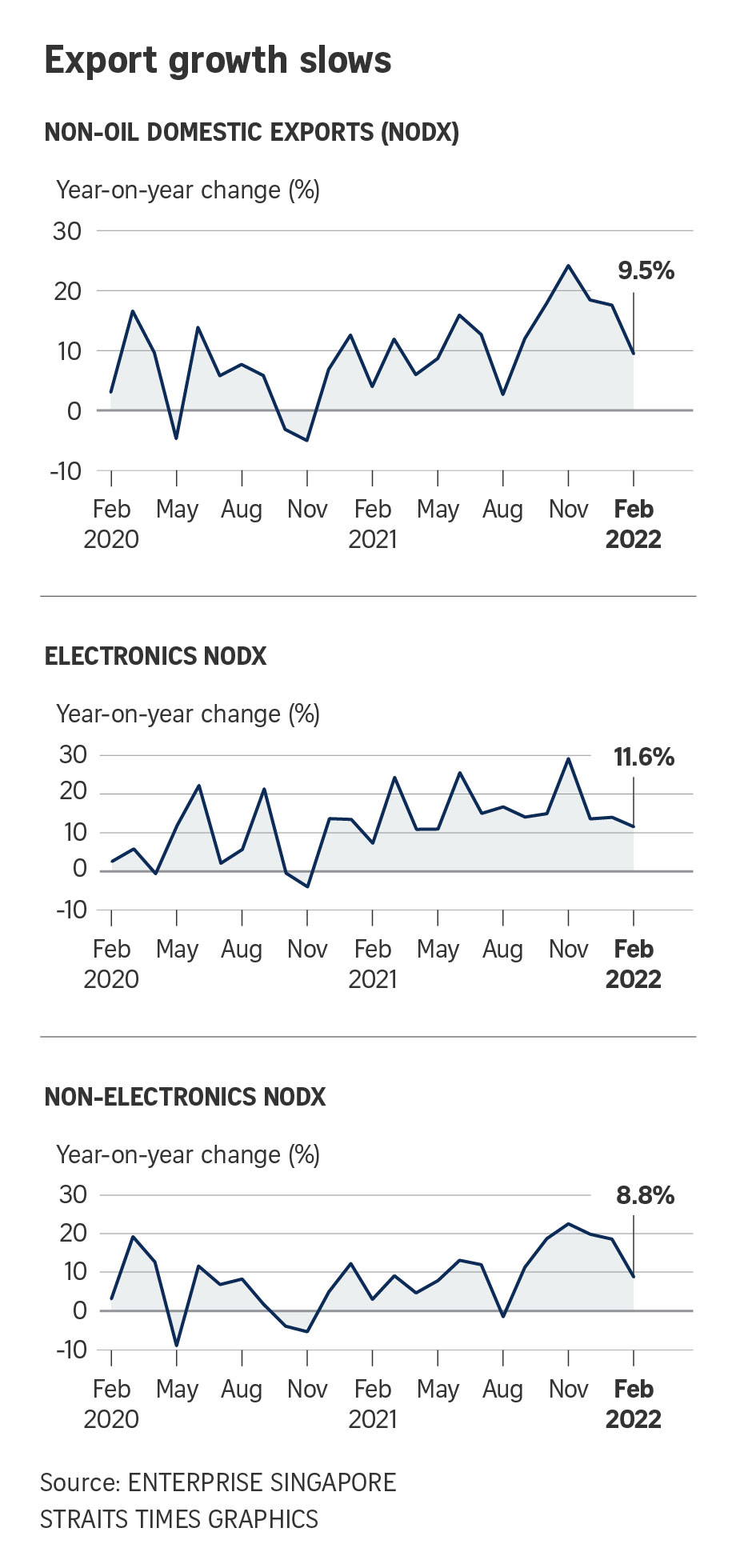Singapore non-oil export growth slows to 9.5% in February, below forecast
Sign up now: Get ST's newsletters delivered to your inbox

Singapore's key shipments continued to expand, but growth slowed with the uncertain global backdrop.
ST PHOTO: MARK CHEONG
Follow topic:
SINGAPORE - Singapore’s key shipments continued to expand last month, but growth slowed amid heightened geopolitical tensions from Russia’s invasion of Ukraine and supply chain disruptions.
Analysts warn of dampened trade demand and possible downside risks for Singapore’s economic growth.
Non-oil domestic exports (Nodx) rose 9.5 per cent year on year last month, according to data released by Enterprise Singapore (ESG) on Thursday (March 17).
Last month's showing was below the median forecast of 16.5 per cent tipped by analysts in a Bloomberg poll, and down from the 17.6 per cent expansion in January.
Electronic Nodx grew 11.6 per cent last month, slower than the 14 per cent year-on-year rise in January. Shipments were largely bolstered by growth in integrated circuits, disk media products and capacitors.
Non-electronic Nodx increased 8.8 per cent last month, down from the 18.6 expansion in January, with structures of ships and boats, pharmaceuticals and petrochemicals the largest contributors to growth.
On a month-on-month seasonally adjusted basis, non-oil exports dipped 2.8 per cent last month, compared with the 5 per cent increase seen the previous month.
This was due to a decline in non-electronic exports, despite growth in electronics shipments.
Nodx reached $17.6 billion last month, lower than January's $18.1 billion, on a seasonally adjusted basis.
Barclays regional economist Brian Tan noted that the lower-than-expected Nodx print stemmed partly from a plunge in shipments of non-monetary gold, which tend to be volatile. A drop in shipments of specialised machinery also contributed to the drag on exports.
But he said the below-expectations showing last month is unlikely to be reflective of a broader drop in external demand, especially as electronics exports rose month-on-month.
“Exports of specialised machinery are also unlikely to stay low for long when there is still ample global demand for semiconductors,” Mr Tan wrote.

ING senior economist Nicholas Mapa said in a report: “With the global growth outlook dimming over the past few weeks, we can expect trade activity to slow further, with Nodx likewise expected to see more moderation in the coming months.”
Positive but slowing non-oil exports expansion will likely sap growth momentum for Singapore, he said.
Oxford Economics senior economist Jung Sung Eun said that, while real exports sustained their growth momentum last month, this is expected to weaken in the coming months as the Russia-Ukraine war dampens global trade and growth prospects, and adds to price pressures.
“Ongoing supply chain disruptions pose further challenges to trade, with localised lockdowns in China adding to temporary disruptions,” she said.
Shenzhen, China’s tech and manufacturing hub, was placed under a seven-day lockdown from March 13 to stem Covid-19 infection spread, with non-essential businesses and public transport shut.
UOB economist Barnabas Gan noted that Singapore’s external environment has remained buoyant despite Covid-19 risks.
The bank remains of the view that Singapore is well-positioned to ride out the endemic Covid-19 recovery into 2022, but also sounded caution over downside risks from rising geopolitical tensions which could depress trade demand and cause raw material shortages.
ESG said that Nodx to the top 10 markets as a whole rose last month, mainly due to higher exports to the European Union, China and Malaysia, driven by an increase in pharmaceutical and specialised machinery shipments.
Oil domestic exports jumped 62.1 per cent last month, extending on the 36.7 per cent rise in January, with higher exports to Indonesia, Australia and the EU.
On the whole, total trade expanded 21 per cent year on year in February, following the 24.9 per cent increase in January.
This was driven by a 22.3 per cent growth in total exports, and a 19.6 per cent rise in total imports.
Growth in overall merchandise trade and non-oil exports is officially forecast to drop to 0 per cent to 2 per cent for the whole of this year, partly due to the high-base effect of last year when Nodx rebounded by 12.1 per cent.

